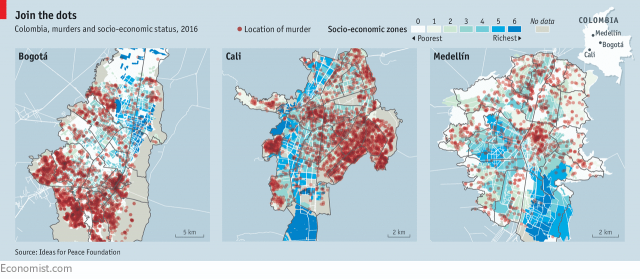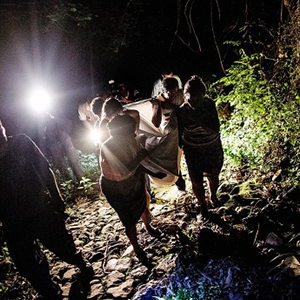Shining light on Latin America’s homicide epidemic
Latin America’s violent crime, and ways of dealing with it, have lessons for the rest of the world
05/04/2018
Originally published on The Economist

ON JANUARY 11th 2017 no one was murdered in El Salvador—a fact that was reported as far away as New Zealand, Thailand and Russia. At the time, the Central American country had the highest murder rate in the world: 81 per 100,000, more than ten times the global average (see chart 1). On most days more than a dozen Salvadoreans lost their lives to gang warfare, police shootings and domestic disputes. On bad days, the number could be three times higher. Murder dominated newspaper headlines, campaign speeches and dinner-table discussions. A day without it was something to celebrate—and reflect on.



Latin America, which boasts just 8% of the world’s population, accounts for 38% of its criminal killing. The butcher’s bill in the region came to around 140,000 people last year, more than have been lost in wars around the world in almost all of the years this century. And the crime is becoming ever more common.
Latin America is also the most urbanised part of the developing world, and that is not a coincidence. Its urban population grew in the second half of the 20th century much faster than those of other regions. By 2000 over three-quarters of the population lived in towns and cities—roughly twice the proportion in Asia and Africa. That move from the countryside concentrated risk factors for lethal violence—inequality, unemployed young men, dislocated families, poor government services, easily available firearms—even as it also brought together the factors needed for economic growth. As other developing economies catch up with Latin America’s level of urbanisation, understanding the process’s links to criminality, and which forms of policing best sever them, is of international concern.
In this regard, it is worth noting that the region’s countries vary a lot. Some countries in the south of the region have urbanised as fast as those in its north, but murder rates in the south remain comparable to that of the United States. The drug trade in the northern part of the region undoubtedly makes a big difference. And some countries where murder rose have since seen it decline.
If lessons from those countries that have turned the tide were promulgated a lot of good could be done. The Small Arms Survey, a research group, has three scenarios for the world up to 2030: one in which murder trends continue; one in which the trends seen in the countries that are doing best with murder in their region are exported to their neighbours; and one in which trends start to match those in some of the worst-performing countries. The difference between the best case and the worst adds up to 2.6m lives.
Latin America’s crisis has been mounting at a time when, in the developed world, murder has been becoming rarer. As Patrick Sharkey, a sociologist at New York University, shows in “Uneasy Peace”, a recent book, the causes of the “great crime decline” America has seen since 1990 are complex and controversial: mass incarceration almost certainly reduced violence, though its impact diminished as a greater share of the population got locked up, leaving broken families on the outside.
Other factors mattered more in other countries. But most of the rich world saw a new stress on the use of data, especially geospatial data, in policing and crime-prevention efforts. That definitely played a role. Some approaches built on knowing precisely what was happening where to whom and why were criticised in terms of both cost efficiency and social justice: “Broken windows” policies stamped down on petty crimes it might have been safe to neglect; “stop-and-frisk” disproportionately targeted young men of colour. But there is now little doubt that, overall, data-driven approaches helped bring down crime rates. And when they succeeded they fostered a new confidence in the police, which encouraged community-driven efforts to reduce crime and co-operate with the authorities, all of which further reduced violence. As Adam Gopnik noted in a review of Mr Sharkey’s book for the New Yorker, a virtuous circle started to roll.
The Latin American trajectory has been the reverse of the rich world’s: the time of greatest concern in the United States was the time of greatest optimism in the south. In the late 1980s and the 1990s the civil wars and military dictatorships that characterised the 1970s and 1980s were giving way to democracies. Tens of millions—some displaced from their farms by guerrilla warfare—flocked to the cities, a willing workforce for the rapid industrialisation that governments hoped to bring about by opening their doors to global trade.
But the economic growth that followed did not match this influx, or the demographic “youth bulge” that exacerbated its effects. Nor did government services such as clinics and schools. People crowded into slums, shantytowns and favelas from where they were hard put to reach jobs. By the early 2010s, the bloodshed in some cities had reached a pitch comparable to that of the internal conflicts that had torn up the region decades earlier (see chart 2).


The causes of the bloodshed varied. Extortion gangs were responsible for a lot in some parts of Central America, drug-trafficking in others (though Costa Rica and Panama, both on the drug route, are relatively peaceful). Institutional weaknesses were widespread. Police and prosecutors in the region were badly trained, underpaid and often corrupt. In some places only one in 20 reports of murder led to a conviction. A penchant for ineffective but brutal government crackdowns often made things worse; grossly overpopulated prisons became crime factories rather than rehabilitation centres. To different degrees in different places, these factors all contributed to a vicious circle, rather than a virtuous one: the worse things got, the less effective efforts to stem the tide became.
But one factor seemed to be constant; where murder was high it was also heavily concentrated. According to Robert Muggah of the Igarapé Institute, a Brazil-based think-tank, approximately 80% of homicides in large and medium-sized Latin American cities occur on just 2% of the streets. Identifying those hotspots is crucial. Randomised-controlled trials of homicide-reduction programmes in cities like New York and Los Angeles have shown that policies which use reliable data to give priority to high-risk places, people and behaviour have the best shot at success.
In most of Latin America those data are lacking. Many homicide reports say only whether the crime was a knifing or a shooting; locations may just be the name of a town. In a report the Inter-American Development Bank (IDB) published in 2012, Lawrence Sherman, a criminologist, concluded that this chronic lack of data “is not an obstacle to solving an important problem. It is the most important problem.”
Truths, not truces
Take El Salvador. In 1996 José Miguel Cruz, a political scientist, gathered data for the IDB’s first regional homicide report there: mayors sent him slips of paper with scrawled tallies marking murders. Today police, prosecutors and coroners meet monthly in San Salvador, the capital, to sort out national totals. But little attempt has been made to understand them, and they are not well used. “Plan Safe El Salvador”, launched in 2015 with support from various international organisations, called for resources to be funnelled to the 50 municipalities which statistics showed to be at highest risk. But because the “municipality prioritisation index” used total crime numbers, rather than rates per person, the plan’s targets for prevention projects were mostly just the biggest towns and cities.
El Salvador’s police claim to collect data good enough to make crime maps that delineate gang territories, but say they cannot release them because doing so could “compromise intelligence operations” and stigmatise residents of violent neighbourhoods. Such claims are common across the region. When they are true, the lack of transparency tends to be ill judged.
Consider the homicide report Mr Cruz worked on. He says that shortly before it was published El Salvador’s president begged the IDB to suppress his country’s figures, worried that they would hurt the economy. But the real toll on GDP comes not from reports on violence, but from violence itself. Latin American governments spend an average of 5% of their budgets on internal security—twice as much as developed countries. A recent IDB study estimates the direct costs of violent crime in the region—measured by such things as spending on police, hospitals, insurance and private security, and the lost wages of prisoners—at $236bn a year, calculated on a purchasing-power basis. At $300 per person, that is much higher than in developed countries. In El Salvador the cost of murder works out at 1% of GDP a year. Countries fear that opening data up to independent analysis will reveal the costly ineffectiveness of their policies. But until data analysis improves, their policies will continue to be ineffective, and often erratic.
That has certainly been the case in El Salvador. In 2004 President Francisco Flores put soldiers on the streets and threw thousands of gang members into prison to clamp down on crime. Murders went up. In March 2012 the government of Mauricio Funes brokered a truce between El Salvador’s three main gangs, giving imprisoned leaders luxuries like flat-screen televisions and fried chicken if they would tell their subordinates to stop killing each other. Murders halved almost overnight, and some criminologists applauded, seeing the policy as a step towards “focused deterrence”—a combination of incentives and threats that is deemed to have worked well in Los Angeles, among other places.
Others were wary, with reason. The truce soon began to unravel, and the gangs began to see violence as a bargaining tool. In early 2015 President Salvador Sánchez-Cerén sent the army back on to the streets and returned gang leaders to top-security prisons. Murders rocketed to 104 per 100,000 people. The number dropped back by 40% over the next two years, something the government put down to “extraordinary measures” in the prisons; for two years tens of thousands of gang members have seen no relatives, no doctors and no daylight. At the same time the number of members of the public shot by police has gone up 15-fold, sparking an international outcry. “The treatment that the state provides shouldn’t be as bad as the sickness itself,” says the UN special rapporteur on extrajudicial executions, Agnes Callamard. And for the past six months the murder rate has been on the rise again.
Some Salvadoreans worry their country is heading the way of Venezuela, which stopped releasing murder statistics altogether in 2005. Luisa Ortega Díaz, then Venezuela’s attorney-general, started releasing some numbers again after attending a regional conference on homicide data in 2015; last year she was sacked and subsequently fled the country. According to the Venezuelan Violence Observatory, which uses press reports, victimisation surveys and leaks from sympathetic government officials to track murders, Venezuela now has the world’s highest homicide rate.
Colombian data exchange
A generation ago that baleful title belonged to its neighbour, Colombia, where the drugs trade and peasants driven into slums by the civil war came together to dreadful effect. In 1994 the murder rate in Cali was 124 per 100,000 people.
Rodrigo Guerrero, the city’s mayor and a surgeon by training, launched a plan inspired by the epidemiological approach some North American cities were taking at the time. He set up “violence observatories” where police, public-health officials, academics and concerned citizens could study crime data. This revealed that most of the city’s murders took place in drunken brawls, not in conflict between gangs, and that they were late at night a day or so after payday. Restricting alcohol sales and gun permits helped cut the homicide rate by 35% in a matter of months.


Long-term results were mixed—some crime was probably displaced rather than prevented, and subsequent mayors discontinued the bans—but Mr Guerrero’s data-driven approach to violence spread. In Bogotá, the capital, data-based policing became the norm.
Some experts believe that the only way for developing countries to curb high homicide rates on a permanent basisis systemic reform. But data-driven policing can buy the time—and create the conditions of trust—needed for such reforms to take place, and can work to boost the gains from all sorts of other approaches. In Medellín, where gains against crime have been even more marked than in Cali, targeted action against the local drug cartel and guerrillas first made things safer, and improvements in infrastructure, including cable cars, helped integrate the slums into the city; but data-driven methods learned from Cali also played a role.
In 2017 Colombia announced a murder rate of 24 per 100,000 people, its lowest in 42 years. That is still high, though, and there are more problems to come. The demobilisation of the FARC (the Revolutionary Armed Forces of Colombia) after decades of guerrilla war has created local power vacuums that could be filled by organised crime, especially if the government does not create opportunities for ex-combatants, coca farmers and young people. “Colombia is not approaching heaven,” says María Victoria Llorente of the Ideas for Peace Foundation. “We’re barely leaving hell, and if we aren’t careful, we’ll stay in limbo.”
A recent proliferation of violence observatories in Latin America—many modelled after Mr Guerrero’s Cali flagship—suggests that governments are realising the need for an evidence-based approach to security policy. But even now only two-thirds of the 60-odd observatories track when and where murders take place, and just half try to determine motives, according to the IDB. In 2016 Ignacio Cano, a Brazilian criminologist, looked at 93 homicide-reduction programmes in the region, including controls on alcohol in Brazil, an advertising campaign exhorting Venezuelans to “value life”, private investigators paid to help public prosecutors in Honduras, a $400m justice reform in Mexico and mediation with criminals in Jamaica and El Salvador. Some coincided with impressive drops in murder rates—but only 16% actually tried to evaluate their impact.
An international campaign called “Instinct for Life”has laid out six principles for reducing murders in Latin America by 50% over the next decade. It stresses both prevention and intervention—and in both cases it sees data as central, whether as a way of revealing what needs to be done or recording the extent to which an intervention has or has not worked. Even without state-of-the-art technology, the campaign says, police could make much better use of the information they already collect.
The rest of the world should take note. Murder already outpaces war as a cause of death. And the world is continuing to urbanise. India and China have accommodated huge increases in urban population while keeping violent crime levels relatively low, in part thanks to economic growth. But other countries exhibit many of the risk factors seen in Latin America a generation ago: widespread displacement as a result of conflict, millions of leftover guns, a demographic bulge, little by way of safety nets and corrupt, ineffective police forces.
The sooner cities and countries build good data analysis into their approach to curbing crime, the fewer of Latin America’s problems they will recapitulate. And they will also spare themselves false hope. A few weeks after that day in El Salvador in January 2017, the police concluded that a body found in a shallow grave had, in fact, been dumped there on January 11th. The murder-free day has yet to dawn.



